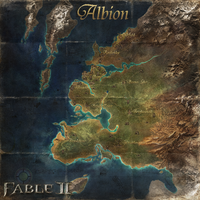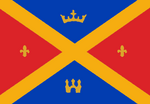Albion is the name of the country in which Fable, Fable: TLC, Fable Anniversary, Fable II and most of Fable III take place.
- For lore on Albion, see Tales of Albion.
Geography
Albion is a very green land, bounded by rich seas to the west and south. In the north, Albion extends to the Ironwash River, beyond which lie the Edgelands. The extent of Albion to the east is not clear. The country lies directly north of Aurora (an Overseas Terrority of Albion which may be full integrated) and indirectly north of the South Islands, and is assumed to be east of the Cities of the West, west of Samarkand and south of the Edgelands. On the opposite side of the unnamed world from Albion is the Eastern Kingdom. Ruins of the Old Kingdom dot the landscape, but most are little piles of rubble these days, being overgrown by vegetation, and being supplanted by modern towns. The most intact ruins today lie underground, such as the Howling Halls. The darkest of all these ruins is Shadelight.
The northern lands of Albion are extremely fertile and well-suited to farming, demonstrated in areas like Oakfield and the Shalefields. The Whitespire Mountains and Echo Hills separate this region from the more prosperous southern areas. Towards the southern part of Albion are several forests, including Greatwood, Silverpines, Brightwood, and Deepwood. Even further south of those lie the vast swamps and marshland of Darkwood and Wraithmarsh, where dangerous creatures such as hollow men and balverines lay. To the east lie the mountains of Albion, including the expansive Mistpeak Mountains, which contain the Dweller Camp. Mount Ruon, the tallest peak in Albion, has not been placed within a known mountain range, and its exact location is unknown.
Large caves stretch underground, many being Old Kingdom Ruins, others being natural, and some having combinations of both, such as The Hole, through which the Mistpeak Monorail line was built. A vast network of Catacombs lie beneath Bowerstone, evidenced by Fairfax Tombs, Lady Grey's Tomb, and the Gargoyle Trove in Fable II, Cesspools, in Fable III, in addition to the extensive sewer system, and the town of Understone built around the time of Fable II. There are also several small caves and mines in the surrounding Millfields area.
Several islands surround Albion. There are a few large islands, such as Witchwood and Hook Coast, but most are small and uninhabited such as Lion's Head Isle, with Knothole Island being a notable exception. Clockwork Island, the Godwin Estate, and Ravenscar Keep have also been settled, though the former two have been abandoned.
In the far north across the Grey Sea lies the Northern Wastes, a sparsely-populated sub-polar tundra consisting of the village of Snowspire and the abandoned settlement now known as the Necropolis. The most northern point of the Northern Wastes is the Archon's Folly.
Once Aurora becomes a part of Albion, under the Hero of Brightwall, Albion's borders encompass more arid terrain. Its southern border is marked by a great door in a closed valley, one of many Auroran ruins from ages past.
Aurora
- Main article: Aurora
Aurora is an Overseas Territory of Albion which becomes part of the Kingdom under the Hero of Brightwall. Aurora serves as a geographically important port for Albion. Aurora is culturally diverse in comparison to the rest of Albion, most people in Aurora live a primitive lifestyle and reside in clay houses which is unique compared to mainland Albion. Albion is far more technologically advanced in comparison to Aurora and more populous due to the fact that most of Aurora is uninhabited as it contains vast deserts.
History
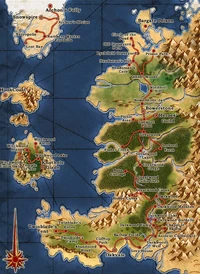
Map of Albion (At the time of The Hero of Oakvale)
The Court
Reign of The Court
The history of Albion is one that is constantly reforged in revolution and blood. The earliest accounts of Albion are purely legend, stating that it was a place of beauty and tranquility. Then three came from The Void: the Knight, the Jack & the Queen of Blades. They became known as "The Court". They coveted Albion and demanded that all men bow down before them. When the people of Albion refused, The Court burned Albion until the earth was black and the air was choked with smoke. They demanded obedience a second time, only to be refused again. As their next punishment, The Court raised the ocean into the sky and flooded the land. A third time The Court demanded that men worship them, promising to usher in an age of peace and end misery. But the few remaining people stood strong against The Court, and refused a third time. So The Court twisted their minds, until brother slew brother, parents abandoned children and friend killed friend. Finally the people of Albion conceded, and bowed to the court. Thus the The Reign of The Court began, where the few people who survived (and their descendants) toiled for many years, erecting structures and monuments to glorify those who came from the void.
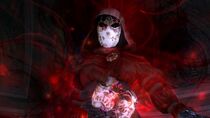
Jack of Blades.
Birth of William Black
In the days where people suffered under The Court's cruelty, a humble blacksmith and his wife had a boy. They named him William Black, and he would become the key to Albion's salvation. Little is known about William's childhood, but as a grown man he amazed many with his powers of mind, by which he was able to protect his village and perform feats that a dozen other men could not equal. These acts came to be celebrated as The Powers of Will.
William eventually grew obsessed with overthrowing The Court and ending their tyrannical rule. One night when he was consulting an old and mysterious tome, he was suddenly transported into The Void. Here he met Jack, who was sat on a throne surrounded by ghastly figures. Jack attempted to enslave William with the powers of an ornate sword, but William fought back - stealing the sword and escaping safely out of the netherworld. The sword spoke to William, it called itself the Sword of Aeons, and promised to help him defeat The Court, but only if he were to offer up his soul in bondage. With the Sword of Aeons, William set off to find The Court. It is said William found the court after a year of searching but no one knows if he was the one who destroyed the court.
Fall of The Court
William scaled the peak of Ruon (Albion's highest mountain) and challenged The Court to combat. The Knight of Blades was the first to appear, and with the Sword of Aeons, William destroyed him completely. Jack was the next to appear. They fiercely struck at each other, until William broke Jack's body. Jack escaped into the Void, to fight another day. The Queen was the last to appear. For weeks their battle raged across Albion. Mountains were raised and valleys were formed by their mighty blows. Finally William slew the Queen, freeing the people of Albion from their yoke. They acclaimed William, who took the title Archon, as their king.
The Kingdom
Rise of The Kingdom
With The Court vanquished, the Archon set his mind to unifying Albion into a great Kingdom. By this time his powers of Will were so great that the world seemed to reshape itself in accordance with his wishes. Cities were built in mere weeks and marvellous machines were constructed that ran on Will alone. Through a thousand years of peace, Albion reigned as the greatest centre of commerce and philosophy that the world had ever known. This was their golden age where the territory of the kingdom extended an unknown distance north into the Edgelands, and its economy traded with at least Samarkand and the Cities of the West.
Exodus of the Archon
Without any enemy to vanquish, the Archon's children, who called themselves Heroes, grew petty and cruel. They used their powers of Will, inherited from their father, to terrorize the people of Albion. A younger Archon might have stopped them, but his time in the Void and his battle of the Queen had infected his body and mind with a wasting illness. Faced with this decay, the Archon traveled back to the Void and purged most of the disease from his body, desperate to ensure that it would not take over his mind and body. This disease formed into the Darkness and the Corruption, the antagonistic forces lead by the Corruptor that would continue to attack Albion for centuries. The rest of the disease continued to take it's toll on the Archon, however, and he subsequently wrapped his body in gold mail and a royal blue cloak before seemingly vanishing from the land. Thus the corruption of the Kingdom began.
Corruption
With the Archon gone, Albion descended into chaos. Three out of every four people were slain in the wars, or died from disease and/or starvation. Meanwhile, the Archon's many descendants vied for power and the kingship. These new rulers were not as kind as the first. Each passing Archon, fearful of coup, brought fresh tyranny to Albion. A giant wall was constructed around the city, to keep citizens in and undesirables out.
The Archon's personal guard, who were encased in armour from birth, enforced their harsh paranoia-driven decrees: no citizens allowed out after nightfall, every citizen must appear when an alarm bell is sounded and any who opposed the Archon's rule were killed along with their families. The people witnessed these cruelties from behind masks that signalled their status while concealing their fear.
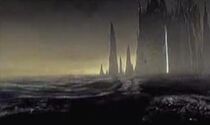
The tattered remains of the Spire.
Fall of The Kingdom
At the pinnacle of the Kingdom, where it had grown to its greatest extent, the latest incumbent Archon demanded the construction of The Spire - a giant tower used to focus all the Will power in the world, to grant the user a single wish. Following The Spire's completion, a rift opened between the Void and Albion that the Corruptor used to send his most powerful lieutenant, the Crawler, into the world. The Old Kingdom's greatest Three Heroes, Blaze, Stone, and Sol faced the creature in battle, combining their powers to close the rift. The trio succeeded in closing the rift, but they only managed to imprison the Crawler, and their power proved to be too much for The Spire. The next morning, the tower was gone and the Old Kingdom lay in ruins, all its inhabitants gone, except those who lived beyond the walls.
Darkest Times
Isolation
After the fall of the Old Kingdom, the few villages that survived fell into isolation and Albion was plunged into a state of anarchy. Without a central government, the settlements drifted apart, and became self-sufficient communities ruled by a local chieftain or duke. Trade with nations beyond the borders became little more than a distant memory. The regions in between the city-states, including those which would become the Edgelands, Greatwood and Witchwood, contained numerous Old Kingdom structures and ruins, where scavengers found and traded ancient objects as mere trinkets. In time, the forests grew over the ruins, and it was as if the rich heritage of Old Albion had never existed.
Bloodshed
The population dwindled, and those who survived would wake each day to a darker world. Distance bred suspicion, which grew into bloodshed. Villagers fought for food, land, livestock and fresh water. Soon, they were even fighting over women of child-bearing age. Mercenaries sold their sword to the highest bidder and fought in a series of petty squabbles. If they did not like the price being offered, they extracted payment by threatening villagers. The Fallow Wars begun, an age of darkness and blood, which would bring Albion very close to extinction.
Then out of the east, hope arrived in the most unexpected of forms - a Bandit and mercenary by the name of Nostro. He pledged to bring peace and prosperity to Albion, once more.
The Guild
Rise of Nostro
In his youth, Nostro was a bandit and mercenary driven by an ambition to leave his mark on the world. He was, however, not without a sense of decency. He did not reach his full potential until he met a wise old man, by the name of Scythe. Scythe was a wraith of man, wizened and stern. He carried an ornate sword and shrouded himself in the now tattered royal blue cloak and tarnished gold armour worn by the first Archon. He seemed to appear out of nowhere and took a profound interest in Nostro.
Scythe saw in Nostro something more than a mere bandit. He sensed that Nostro unknowingly possessed the power that all the first Archon's descendants shared. Scythe hatched a plan: if he could properly guide Nostro, this bandit could achieve great things. He might even once again unite Albion and undo the damage done by William Black's children. And so Scythe began to tutor Nostro in how to be a leader of men.
Establishment of The Guild
Following Scythe's counsel, Nostro set about returning security and prosperity to Albion. First, he gathered men and women throughout Albion and founded the Guild, where they could train to become real Heroes. Meanwhile Scythe tutored Nostro in the ways of Will. Using his new found power, along with Scythe's sage counsel, Nostro forced peace on the warring people of Albion. However, any hopes of restoring Albion to its former greatness were in vain.
While the Guild was still taking shape, Nostro commissioned a number of other great creations. One of which was the Witchwood Arena, a giant Colosseum intended to be a venue for which anyone could settle disputes in public. At the same time, Nostro's blacksmiths forged a sword known as the Tears of Avo, patterned on reports of the Sword of Aeons, which had been lost with the Archon's disappearance.
Fall of Nostro
However, Nostro fell increasingly under the sway of a power-hungry courtesan named Magdalena. Eventually she corrupted Nostro to the point where the Arena was debased into a source of popular entertainment and the Heroes' Guild became nothing more than a house of mercenaries driven by a lust for profit and fame. These developments disgusted Scythe, who could only watch as Nostro and the Guild fell into disrepute. Finally he vanished, leaving Nostro to his fate.
Death of Nostro
Near the end of his life, Nostro could finally see how power had corrupted him, and how far short he had fallen from his youthful ideals. By then his followers and even his wife had long since abandoned him. Isolated, he was easy prey for an assassin who slipped poison into his food. Nostro knew that he was dying, so called on his old mentor Scythe, to sit vigil with him in his final hours. He died, in peace with himself, with dawn's first light and was then buried in Lychfield Graveyard. However, Nostro's spirit, discontent with the un-heroic nature of his death continued to haunt the world, longing for a death that would fit his image.
After Nostro's death, Albion continued to grow and thrive, as did the Heroes' Guild. The Guild came to be led by a succession of Will users, who individually varied from well-meaning to cruel in their intentions. The Guild itself adopted a simple code: complete the quest to the letter, ask for payment up front, and obey the local law enforcement unless a Hero is on a quest.
Avo and Skorm
Creation of the Churches
Four centuries prior to the events of Fable, a trader uncovered two sites where Will energy was exeptionally strong. One site seemed to heal people that visited it, the other, however, inflicted pain and gave thoughts of blood lust. The trader decided that he would create two opposing temples and collect tithes that people came to donate. Eventually people actually came to believe in Avo and Skorm as real deities. In The Lost Chapters, the Oracle of Snowspire reveals that Avo and Skorm are "nothing but false idols". Despite the Oracle's statement however, a disembodied voice can be heard scolding the player if they kill the acolytes of Avo and Skorm in their temples.
War of the Churches
As revealed by the description of the Holy Warrior Helm and Daemon Warrior Helm (found in the Northern Wastes), 200 years prior to the events of Fable, around when Nostro lived, a holy war erupted between the two churches. The outcome of the war is unknown, but it should be noted that both churches are present in Fable.
The Hero of Oakvale
Many years after the founding of the Heroes Guild, a famous heroine known as Scarlet Robe, who was said to have a connection to the bloodline of the Archons, got married to Brom, gave birth to a daughter, Theresa, and then to a son, who would later become known as the Hero of Oakvale. When the Hero was a child, his home village of Oakvale was raided and destroyed by bandits on his sister's birthday; it seemed that the Hero's entire family had perished. An old Hero named Maze rescued the boy, and convinced him to join the Heroes' Guild to be trained to become a Hero. The Hero then embarked on a journey to uncover the reason behind his village's destruction, discover his destiny, and learn the true fate of his family.
- Main articles: Fable Storyline; Hero of Oakvale
The Fall of the Guild
After the Hero of Oakvale had defeated Jack of Blades (for a second time as a Dragon), the Heroes of the Guild became lazy and self-important. The Common Man was placed second to a Hero and because the Heroes were so strong and powerful there seemed to be no way of stopping their selfish ways.
This changed when someone discovered the flintlock mechanism. Using powder of the weaponry from Samarkand, the flintlock mechanism was invented and the firearm was born. In the age of the firearm, the Oakvale Anti-Hero committee was established and eventually a revolt was made and the Heroes Guild was burned. While this is viewed as a positive event overall, it created a great amount of turmoil for any decent Hero. The Arena, where the Heroes once fought for the people's entertainment, was used for execution. The Heroes were allowed to fight for their freedom, but were killed regardless. The Heroes attempted to fight back, which resulted in a battle within Bowerstone, but ultimately they failed.
Regardless, this ushered in a brief age of Enlightenment, where knowledge and philosophy were encouraged and many advances were made. A few Heroes managed to survive the revolt, among them the Hero of Southcliff, a direct descendent of the Hero of Oakvale, who overthrew the dictator of Southcliff.
The Decade of Enlightenment
After the Heroes Guild was burned, there occurred a ten-year period during which logic, philosophy, and engineering were encouraged. Around the same time as the destruction of the Heroes Guild, the Churches of Avo and Skorm dissolved and people began to try to understand the world. Navigators invented the Sextant and began to accurately map the world. There are clues however that they had already discovered that the world was round, because in the Heroes Guild in Fable there are globes, or star maps. Albion was also remapped more accurately, thus creating discrepancies between the maps of Fable and Fable II. At the end of the decade the Witchwood Arena was decommissioned and the Westcliff Crucible was constructed as a replacement.
Light and Shadow
Not long after the dissolution of the Chapel of Skorm, the Temple of Shadows was formed within a dark Old Kingdom cathedral. The original cult was a powerful and feared entity, but was disbanded after the loss of most of its members in a demon-summoning gone wrong. The new Temple of Shadows was recently established by Cornelius Grim, but never reached the infamy of its predecessor. The group was mostly formed from rich folk who saw evil as nothing more than a hobby, but the forces they worshiped were more real than Skorm. The sacrifices they made ranged from demented, to reversing someone's sex, to turning them into chickens, to pure evil (such as turning someone into a living Shadow), to simply killing someone on the spot. The group worked on a weekly schedule, with events such as Torture Tuesday, and Poker Night Friday.
On the other side of the spectrum however was the Temple of Light. A lone missionary went on a desperate pilgrimage, and decided to wander into to a dark cave, expecting to find nothing. However, the man did find something. He found the Wellspring of Light and a golden acorn. Using the pure waters from the cave, the golden acorn was planted and from that came the Golden Oak, a tree that makes all the surrounding lands fertile for a few decades before producing another acorn and dying. The man, now known as Albert the Luminous, founded the Temple of Light and from the Golden Oak, the small farming community of Oakfield was born.
The Tattered Spire
Many years later, the fate of Albion would once again come to rest in the hands of an unlikely Hero from the ancient bloodline, whose path to greatness began on the heels of tragedy.
- Main articles: Fable II Storyline; Hero of Bowerstone
The Industrial Revolution
Following the events of Fable II, the Hero, inspired by a vision from the seer Theresa, was able to unite the land of Albion under their rule with Bowerstone as the nation's capital. Thus Albion was united as a monarchy for the first time since the collapse of the Old Kingdom, with a descendant of William Black and the Archons of old on the throne. This period saw a great rise in technology and industry that extended into the northern Edgelands. Fifty years after the events of Fable II, the Hero of Bowerstone has since passed away. In the Hero's place, Albion is ruled by his/her son, a tyrannical king, whose ruthless will has accelerated the Industrial Revolution at the cost of human dignity. Great machines brought wealth to the rich. However, they also brought gigantic slums, in which people are put to work in the factories. People are discontent and revolution is in the air.
- Main articles: Fable III Storyline; Hero of Brightwall
Post-Industrial Revolution
Fifty years after the events of Fable III, the standing monarch of Albion has disappeared, and there are no apparent heirs to the bloodline. The march of industry continues apace, and the denizens of the northern Edgelands are fleeing their dangerous home to mainland Albion. It is during this troubled time that the darkness returns to threaten Albion in the form of the Corruption. With no Heroes having been born that can stop it, one will have to be made.
- Main articles: Fable: The Journey Storyline, Gabriel
Demography
Civilization is spread across the lands of Albion, such as Oakfield and Brightwall, with many of the settlements concentrated on the western coast, including Westcliff, Southcliff, Bloodstone, and the great capital city of Bowerstone. Coastlines with more limited communities included Rookridge, Oakvale, and Driftwood, while a number of settlements can be found on the islands near Albion, such as Snowspire, Knothole Glade, Clockwork Island, and the settlement found on Knothole Island. The northern part of the mainland seems to be more cultivated for use of farming, as seen from the small community of Oakfield. Further north, the Dwellers of the Edgelands make their summer camp in the fertile lands of Shalefields.
Society
Government and Law
The land of Albion in the Fable period is notably devoid of a strong system of government and laws, leading to a laissez-faire attitude for most aspects of society. Homosexuality, same-sex marriage, and polygamy are universally legal and widely accepted. Extramarital affairs, however, are taboo and the source of much contention among married couples. There is also a law that does not allow you to enter a town with unsheathed weapons as you are deemed a threat and hazard. This particular law is heavily enforced in Bowerstone; there, people are not even allowed to carry a weapon on their person. Conversely, this law is completely void in Knothole Glade. Obviously, murder is considered incredibly evil as are breaking into a house, vandalism, theft, or attacking innocent civilians and guards, but the worst punishment is a fine and being thrown out of town at the same time, at least for some heroes. There are also prostitutes in Albion but it isn't explicit as to whether this is legal or not.
In the time of Fable II, Albion still lacks a central ruler and is divided into small city-states that dot the landscape. Major city states include, but are not limited to, Bowerstone, Southcliff, Bloodstone, Westcliff and Oakfield. They usually have a local ruler like a Mayor, Duke, or Chief/Chieftain. There have been times when Albion was united under the rulership of a King or Queen, however most of these positions, including King, have no real power and act as a figurehead. No elections are held either; these positions are usually given to people with the most wealth or property, or to those who are the most famous.
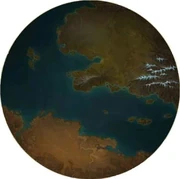
Albion and Aurora in Fable III
By Fable III, Albion is united and its government has become far more centralised. The position of King and Queen has been restored by the Hero of Bowerstone, with true political power not seen since the Archons. This unity has caused great advances in technology, exploration and scientific research. The country now possesses a standing army which maintains order, but more remote areas and roads still remain lawless, being too dangerous to patrol.
During the first year of the rule of the Hero of Brightwall, the southern territory of Aurora becomes part of the Kingdom of Albion. However, it is unclear whether Aurora is added as an equal part of the kingdom, or exploited as a colony for its resources.
Culture
Albion is extremely diverse in terms of culture, with large industrious and wealthy cities such as Bowerstone, towns where smuggling and prostitution is a common occurance, like Bloodstone and Westcliff, and idyllic villages like Oakvale and Oakfield. Travellers are common occurances in areas like Driftwood and Bower Lake respectively. Perhaps, Albion's culture varies more overseas, in areas like Aurora, The Northern Wastes, Knothole Island and Knothole Glade which have developed highly unique cultures due to total isolation from mainland Albion and it's inhabitants - some areas of mainland Albion have also became isolated, like Dweller Camp in Mistpeak. Areas of high wealth tend to be estranged from other areas, such as Millfields, Bowerstone North, Fairfax Castle and, most notoriously, Clockwork Island.
Economy
The economy is completely unregulated and based primarily on agriculture, trade, and services, with little industrial activity until Albion's Industrial Revolution. The currency of Albion is the gold coin, and nearly every trade-able item in the land has a "national standard" of what each item is worth in gold. It should be noted, however, that items are rarely sold for their exact worth, especially in taverns and the Guild gift shop, so be careful when getting rid of things that you may find useful later on in the game.
Religion
In Fable, religion is based upon the belief of two deities: Avo and Skorm. Avo is a benevolent deity, who is worshipped in a temple in Witchwood - The Temple of Avo - through the giving of tithes. Avo rewards those who make large donations with youth, titles, and even weaponry. Skorm, on the other hand, is a devil-like deity who demands human sacrifices in exchange for gold, temporal power, and weaponry. The Chapel of Skorm is located in Darkwood.
The two deities are said to be nothing more than false idols by the Oracle of Snowspire. However, the Oracle also hints the existence of more real gods saying that the balvorn existed when gods and demons were the primary force and that there was a war of the gods in which krakens were created. In addition, Jack of Blades compares his power to that of the gods and demons that the people of Albion feared and worshipped.
In Fable II, religion follows the temples of Light and Shadows. Like its predecessor, the Temple of Light accepts donations of Gold, and rewards the player with goodness, youth, and even a weapon of great power (The Rising Sun), However they are granted an amount of general experience depending on the amount you are donating and the time. Donating at the Sun's Zenith (Mid-day) will give you more experience, as well as The Rising Sun if you haven't acquired it. On the other hand, the Temple of Shadows requires human sacrifice for evil, gold, and another weapon of great power(The Maelstrom).
By Fable III, worship seems to have taken secondary precedence in the face of the Industrial Revolution and the relentless tyranny of King Logan. However, within Mourningwood, one can find the remains of a temple dedicated to an unknown force known as the Dark Sanctum. Should the Hero choose to do so, they can restore this site par the orders of Lesley. As it was with Cornelius Grim's Temple of Shadows, the worshippers in the Dark Sanctum participate in twisted rituals and sacrifices, some of which incur great rewards, like The Tenderiser.
Entertainment
Entertainment is provided at taverns, with their collection of beer, singers, and gambling. Also, a clandestine organization of fight clubs is prevalent in most of the major settlements, meeting solely at night time. There are also various games played throughout Albion, most notably Oakvale's "Chicken Kicking" contest, the Fishing Competition held in Greatwood, and the Archery Competition held just outside Knothole Glade. The Arena also provides gladiatorial style combat entertainment for those who make the journey out to Witchwood. Albion's largest known brothel during this time was the Darkwood Bordello.
By the time of Fable II, hundreds of years later, the Heroes Guild was disbanded, and the Arena lay in ruins, yet the villagers of Albion still hungered for the Arena's spectacle, and the Crucible was built out of the living rock of Westcliff, where non-Heroes can compete, going through a gauntlet of different creatures, much like the original Arena. The first champion of the Arena was a simple farmer named Thresher Jim, who ushered in the new celebrity culture of the Crucible. Many champions would come, but the best was Mad-Dog "The Strangler" McGraw, whose time would become the set standard on which other competitors would be judged. In the same area, there is the Westcliff shooting range. Bards and gambling are still prevalent through most towns, and in some of the seedier parts of Albion, prostitutes, of both genders, can be found. Books, especially those written by Meredith Sock, are extremely popular at the time.
At the advent of the Industrial Revolution in Fable III, entertainment has evolved with the times. The pub games of the past have seemingly disappeared, possibly because there was little time for such enjoyments during the Industrial Revolution. Instead, entertainment mostly consists of a series of elaborate games played by Albion's citizenry, such as the shooting range at the Mercenary Camp, the chicken races found in Brightwall, or the spectacle provided by Reaver's Wheel of Misfortune. Less complex games, like Hollows and Hobbes, are also played. Music seems to be more popular during this era as well, with lute players being found throughout Bowerstone and Brightwall-the player can take part in lute playing in the City of Aurora, Bowerstone Market, the Dweller Camp, and Brightwall. Books are still readily provided by the Brightwall Academy, and plays by the likes of Philipth Morley are still popular during this era. Prostitution is also a popular venue of entertainment, and can be legalized by the player when they become monarch.
Trivia
- Albion (Αλβιών) is the oldest known name for Great Britain. It was written down by Greek merchants from Massila, current day Marseille, who traveled through Gaul and possibly through Brittannia itself.
- During the creation of Canada, the country was almost named Albion.
- In Fable II you can sometimes hear characters saying, "They say the world's a lot bigger than it was 500 years ago," referencing how the regions in Fable II were much larger than the regions in Fable.
- By the events of Fable III the civilian population was at least 6,500,000.

